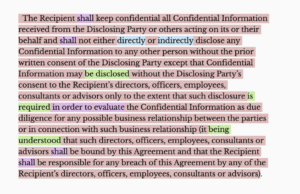 A non-disclosure agreement or NDA is a common contract between contractors and large companies. It’s kind of a prenup covering the relationship, where we writers and other contractors promise not to divulge the secrets to be shared with us.
A non-disclosure agreement or NDA is a common contract between contractors and large companies. It’s kind of a prenup covering the relationship, where we writers and other contractors promise not to divulge the secrets to be shared with us.
You can bet the lawyers have this buttoned down to protect the company every which way. But how are they doing at coming up with a contract everyone can understand?
In my experience, not well. Exhibit A: An opening sentence that’s 144 words, flagged by the Hemingway Editor’s pinky-red alert as extremely difficult to read:

It’s in the company’s best interests to make sure the “Recipient” clearly understands what’s involved in keeping things confidential. Studies show that the best sentence length for that understanding is an average eight to 14 words. At 10 times that desired length, this opening sentence doesn’t do it.
Text with high readability is “clear, concise, and easily understandable, making it accessible to a broader audience.” So says a post on how to use the Flesch-Kincaid Grade Level formula, which determines reading ease. Applying this formula to the 144-word sentence results in a score of minus 89.7 out of 100, “readable” at the mythical grade level 61.5. The Hemingway Editor considers this “post-graduate.” That’s the level of “light reading” found in scholarly journals.
In the April issue of my newsletter, Wordnerdery, I rewrite this monster sentence to make it easier to understand. The result is half the number of words divided into five sentences, with an average sentence length of 14.8 words. Have a look and let me know how you think it came out.
Wordnerdery is a quick read about words, effective/expressive writing, newsletters and more. Are you a subscriber yet? If yes, thanks for reading! If not, you can sign up right now. In keeping with Canadian and American anti-spam laws – and just plain good manners – you can easily unsubscribe any time.
